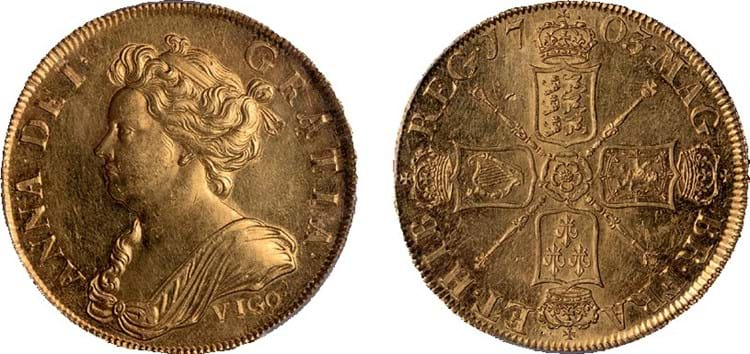The story of the five-guinea gold ‘Vigo’ coins is well documented. Putting a gloss on a failed naval operation aimed at taking Cadiz in 1702, an Anglo-Dutch fleet had managed to seize gold and silver from (near-empty) Franco-Spanish treasure ships coming back from the Americas.
The treasure was paraded through London before it was received at the Royal Mint by the Master of the Mint, Sir Isaac Newton. At the request of recently crowned Queen Anne, the word Vigo – denoting the battle of Vigo Bay on October 12, 1702 – was added to coins made from the bullion.
Collectors often encounter silver coinage (sixpence, shillings, halfcrowns and crowns) made from the treasure, but the 7.5lb of gold produced a few coins that are all extremely rare.
Three die types
Least minted were the five guineas of 1703. The 15-20 of these numismatic trophies that survive are sub-divided into three minutely different die types. What made this coin at Baldwin’s particularly special (perhaps one of only two) was the positioning of the word Vigo close to the queen’s shoulder.
It was also in exceptional condition: despite a few light surface marks it is the finest of the issue (graded MS62).
“The market for top-five guineas is very strong and this is the great English milled coin,” said Stephen Fenton of Baldwin’s.
Although the price was below the low estimate of $1m, it bettered by some distance the previous record for a British coin set only weeks before.
Fenton had been in the room in November when a gold proof of William Wyon’s 1817 ‘Three Graces’ crown had sold in Tokyo at Yen90m (£630,000).
Prior to that, the previous auction record for a British coin was the £430,000 bid in 2014 (also at Baldwin’s) for a proof for the 1937 Edward VIII gold sovereign made before the Abdication.















